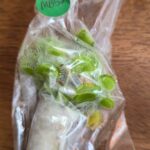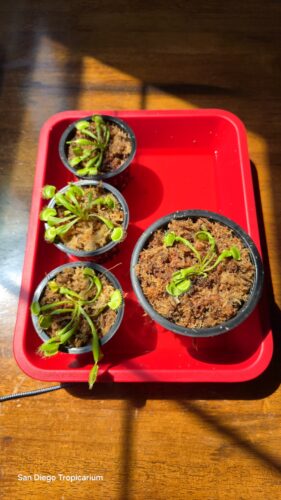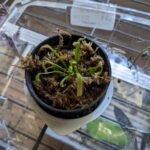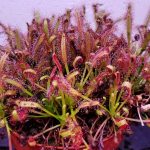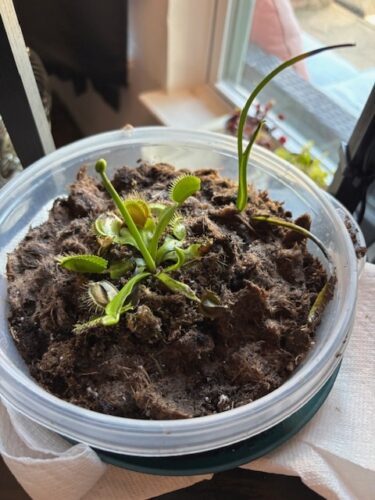Why Buy From CarnivorousPlants.com?
Are you looking for plants that eat insects? Explore our selection of rare and exotic plants and build your collection!
Source: https://www.carnivorousplants.co.uk/
Latest Customer Reviews (View All)

I received the plant today! it's wonderful. I'm very pleased with the one you picked for me.
How long should it sit in the net pot in the w...More
I received the plant today! it's wonderful. I'm very pleased with the one you picked for me.
How long should it sit in the net pot in the water before I can place it in a ceramic pot? Tutorials online say Nepenthes don't like to sit in water, I just want to make sure I'm treating it right.

Thanks for the follow up! I included pics from after potting the plants. The fly trap looked the worst of them, I think it got a l...More
Thanks for the follow up! I included pics from after potting the plants. The fly trap looked the worst of them, I think it got a little crunched in shipping, a couple of the mouths fell off. I don't think it will be life ending. But would love any feedback since I am still learning about carnivorous plants. I have a couple sundews already and a pitcher that have been going strong for about a year now, which is fantastic here in the dry mountains of Arizona.
Currently the bog is in a humidity controlled tent, the plants in there have plenty of gnats for the plants to feed off of and 16 hours a day of light from a t8 rig. The others are in the living room, also getting about 16 hours of good light from both indirect sun and supplemental led sources. I did deviate from your directions a bit, and mixed some parent material into the sphagnum moss. It's the same material my other existing plants came in and have been surviving in, and then I read your instructions on the fly trap and not to do that. It's a super low density, just what the sphagnum could grab for itself, and hopefully that won't be too detrimental to the plants because that would be awful and entirely on me. I split one of the sundews because it had three plants in it, and each now has its own pot. Other than that, I'm waiting a few days to see how the moss sets up in the baskets before seeing if there's any room for topping off.
Each container has a reservoir and enough distilled water that there is good contact between the moss and the water. Because where I live we have extremely low humidity most of the year, I tend to need to over saturate the plants, hence making sure they are sitting in something, but it's still a work in progress to refine the watering strategy to a science. I am hoping the long moss will help, but I may need to get new containers that work for the baskets sent so the water level can be higher and reduce loss to evaporation.
And thank you for the moss. I appreciate the extra as it has gone to orchids and my other carnivores. I'm not sure I could ask for a better outcome as a first time customer. Thanks for being an outstanding vendor.
Questions:
There was no list of the plants that were in the bog, is there any way to find out what they are? I work in permaculture and it's likely that I will wind up propagating some of the plants when the opportunity arises. Knowing which species can be helpful when trying to give them away. Plus learning how to identify is always a good practice when it comes to plants.
When I purchased the bog, the pictures gave the impression the kit would come in an actual pot, not only a hydro basket. Would it be possible to offer a pot that fits the basket too? Currently I'm using a dog treat container as the reservoir because it all fits quite nicely until I can find something more suitable for the long term benefit of the plants. It would have been nice if the bog had that included already, but not sure that is an option. And again it's my fault for not reading more thoroughly.
Would it be ok to follow up in a few days after they have had a chance to settle in and see if I need to take any further steps to make sure the plants have the best shot I can offer them?
If there are any questions I can answer about what I have done, please feel free to ask.
Hope you have a fantastic week,
Charles

Thanks for the follow up! I included pics from after potting the plants. The fly trap looked the worst of them, I think it got a l...More
Thanks for the follow up! I included pics from after potting the plants. The fly trap looked the worst of them, I think it got a little crunched in shipping, a couple of the mouths fell off. I don't think it will be life ending. But would love any feedback since I am still learning about carnivorous plants. I have a couple sundews already and a pitcher that have been going strong for about a year now, which is fantastic here in the dry mountains of Arizona.
Currently the bog is in a humidity controlled tent, the plants in there have plenty of gnats for the plants to feed off of and 16 hours a day of light from a t8 rig. The others are in the living room, also getting about 16 hours of good light from both indirect sun and supplemental led sources. I did deviate from your directions a bit, and mixed some parent material into the sphagnum moss. It's the same material my other existing plants came in and have been surviving in, and then I read your instructions on the fly trap and not to do that. It's a super low density, just what the sphagnum could grab for itself, and hopefully that won't be too detrimental to the plants because that would be awful and entirely on me. I split one of the sundews because it had three plants in it, and each now has its own pot. Other than that, I'm waiting a few days to see how the moss sets up in the baskets before seeing if there's any room for topping off.
Each container has a reservoir and enough distilled water that there is good contact between the moss and the water. Because where I live we have extremely low humidity most of the year, I tend to need to over saturate the plants, hence making sure they are sitting in something, but it's still a work in progress to refine the watering strategy to a science. I am hoping the long moss will help, but I may need to get new containers that work for the baskets sent so the water level can be higher and reduce loss to evaporation.
And thank you for the moss. I appreciate the extra as it has gone to orchids and my other carnivores. I'm not sure I could ask for a better outcome as a first time customer. Thanks for being an outstanding vendor.
Questions:
There was no list of the plants that were in the bog, is there any way to find out what they are? I work in permaculture and it's likely that I will wind up propagating some of the plants when the opportunity arises. Knowing which species can be helpful when trying to give them away. Plus learning how to identify is always a good practice when it comes to plants.
When I purchased the bog, the pictures gave the impression the kit would come in an actual pot, not only a hydro basket. Would it be possible to offer a pot that fits the basket too? Currently I'm using a dog treat container as the reservoir because it all fits quite nicely until I can find something more suitable for the long term benefit of the plants. It would have been nice if the bog had that included already, but not sure that is an option. And again it's my fault for not reading more thoroughly.
Would it be ok to follow up in a few days after they have had a chance to settle in and see if I need to take any further steps to make sure the plants have the best shot I can offer them?
If there are any questions I can answer about what I have done, please feel free to ask.
Hope you have a fantastic week,
Charles
Thanks for the follow up! I included pics from after potting the plants. The fly trap looked the worst of them, I think it got a l...More
Thanks for the follow up! I included pics from after potting the plants. The fly trap looked the worst of them, I think it got a little crunched in shipping, a couple of the mouths fell off. I don't think it will be life ending. But would love any feedback since I am still learning about carnivorous plants. I have a couple sundews already and a pitcher that have been going strong for about a year now, which is fantastic here in the dry mountains of Arizona.
Currently the bog is in a humidity controlled tent, the plants in there have plenty of gnats for the plants to feed off of and 16 hours a day of light from a t8 rig. The others are in the living room, also getting about 16 hours of good light from both indirect sun and supplemental led sources. I did deviate from your directions a bit, and mixed some parent material into the sphagnum moss. It's the same material my other existing plants came in and have been surviving in, and then I read your instructions on the fly trap and not to do that. It's a super low density, just what the sphagnum could grab for itself, and hopefully that won't be too detrimental to the plants because that would be awful and entirely on me. I split one of the sundews because it had three plants in it, and each now has its own pot. Other than that, I'm waiting a few days to see how the moss sets up in the baskets before seeing if there's any room for topping off.
Each container has a reservoir and enough distilled water that there is good contact between the moss and the water. Because where I live we have extremely low humidity most of the year, I tend to need to over saturate the plants, hence making sure they are sitting in something, but it's still a work in progress to refine the watering strategy to a science. I am hoping the long moss will help, but I may need to get new containers that work for the baskets sent so the water level can be higher and reduce loss to evaporation.
And thank you for the moss. I appreciate the extra as it has gone to orchids and my other carnivores. I'm not sure I could ask for a better outcome as a first time customer. Thanks for being an outstanding vendor.
Questions:
There was no list of the plants that were in the bog, is there any way to find out what they are? I work in permaculture and it's likely that I will wind up propagating some of the plants when the opportunity arises. Knowing which species can be helpful when trying to give them away. Plus learning how to identify is always a good practice when it comes to plants.
When I purchased the bog, the pictures gave the impression the kit would come in an actual pot, not only a hydro basket. Would it be possible to offer a pot that fits the basket too? Currently I'm using a dog treat container as the reservoir because it all fits quite nicely until I can find something more suitable for the long term benefit of the plants. It would have been nice if the bog had that included already, but not sure that is an option. And again it's my fault for not reading more thoroughly.
Would it be ok to follow up in a few days after they have had a chance to settle in and see if I need to take any further steps to make sure the plants have the best shot I can offer them?
If there are any questions I can answer about what I have done, please feel free to ask.
Hope you have a fantastic week,
Charles

Thanks for the follow up! I included pics from after potting the plants. The fly trap looked the worst of them, I think it got a l...More
Thanks for the follow up! I included pics from after potting the plants. The fly trap looked the worst of them, I think it got a little crunched in shipping, a couple of the mouths fell off. I don't think it will be life ending. But would love any feedback since I am still learning about carnivorous plants. I have a couple sundews already and a pitcher that have been going strong for about a year now, which is fantastic here in the dry mountains of Arizona.
Currently the bog is in a humidity controlled tent, the plants in there have plenty of gnats for the plants to feed off of and 16 hours a day of light from a t8 rig. The others are in the living room, also getting about 16 hours of good light from both indirect sun and supplemental led sources. I did deviate from your directions a bit, and mixed some parent material into the sphagnum moss. It's the same material my other existing plants came in and have been surviving in, and then I read your instructions on the fly trap and not to do that. It's a super low density, just what the sphagnum could grab for itself, and hopefully that won't be too detrimental to the plants because that would be awful and entirely on me. I split one of the sundews because it had three plants in it, and each now has its own pot. Other than that, I'm waiting a few days to see how the moss sets up in the baskets before seeing if there's any room for topping off.
Each container has a reservoir and enough distilled water that there is good contact between the moss and the water. Because where I live we have extremely low humidity most of the year, I tend to need to over saturate the plants, hence making sure they are sitting in something, but it's still a work in progress to refine the watering strategy to a science. I am hoping the long moss will help, but I may need to get new containers that work for the baskets sent so the water level can be higher and reduce loss to evaporation.
And thank you for the moss. I appreciate the extra as it has gone to orchids and my other carnivores. I'm not sure I could ask for a better outcome as a first time customer. Thanks for being an outstanding vendor.
Questions:
There was no list of the plants that were in the bog, is there any way to find out what they are? I work in permaculture and it's likely that I will wind up propagating some of the plants when the opportunity arises. Knowing which species can be helpful when trying to give them away. Plus learning how to identify is always a good practice when it comes to plants.
When I purchased the bog, the pictures gave the impression the kit would come in an actual pot, not only a hydro basket. Would it be possible to offer a pot that fits the basket too? Currently I'm using a dog treat container as the reservoir because it all fits quite nicely until I can find something more suitable for the long term benefit of the plants. It would have been nice if the bog had that included already, but not sure that is an option. And again it's my fault for not reading more thoroughly.
Would it be ok to follow up in a few days after they have had a chance to settle in and see if I need to take any further steps to make sure the plants have the best shot I can offer them?
If there are any questions I can answer about what I have done, please feel free to ask.
Hope you have a fantastic week,
Charles


We received the plant yesterday and it looks pretty good.
Attached is a pic of it in it's new home.
After a couple of days on the kitch...More
We received the plant yesterday and it looks pretty good.
Attached is a pic of it in it's new home.
After a couple of days on the kitchen table it will go outside.
Regards,
Chuck


Thanks and I can fill...More
Thanks and I can fill up the pitcher with distilled water half way correct?
Thanks. Vito

Hello, I received the pant today. When I touched them they seem to be a bit hot (more than I thought). They do look a bit sad but I am not sure if...More

Hello, Once I received them they did look a little shriveled and hot to the touch. I can only assume this is due to shipping. I have been following ...More

From our nursery to your collection: how we grow your plants!
An exciting behind-the-scenes look into our operation.
Shop Now | Stock List
Why Purchase From CarnivorousPlants.com?

We’ve been in business selling carnivorous plants full time since 2009.
When you make a purchase from our website, you are supporting an American family-owned local business. Our plants put food on our table and make our livelihoods possible. God bless America and long live the USA.
We only sell tissue-cultured, propagated, and seed-grown plants.
We never have and never will possess any wild-harvested plants in our facility. Part of what makes this hobby exciting for us is knowing we are doing our part to preserve nature through educating customers and providing them with genetically superior plants that have withstood the tests of time and demand.
We offer the most generously-sized carnivorous plants on the market.
The top photo shows a Venus flytrap we recently shipped to one of our customers. The bottom photo was emailed to us from a customer showing a competitor’s flytrap they bought and received. Both plants were labeled “large” on the respective websites they were purchased from. The photos speak for themselves.
You can rest assured that when you receive a “large” plant from us, it will indeed a large (if not larger) plant. We walk the extra mile to ship customers the largest plants available in the market. In fact, one of our “large” plants would likely be classified as a “monster” or “mother plant” on a competitor’s website for triple or quadruple the price if they listed the identical plant.
Free shipping!
Believe it or not, each of our carnivorous plants comes with free standard shipping, which typically takes between 2-6 days upon purchase. Due to the sheer volume of plants we ship, we have negotiated shipping rate savings, which we pass onto our customers. Expedited and overnight options exist for additional cost.
We breed some of the rarest and most desirable cultivars.
We offer rare cultivars of certain plants that are highly sought after by collectors. For example, we are fully stocked with the King of all Venus flytraps: the famous B52. We also have Dente, King Henry, and Akai Ryu (Red Dragon) varieties in stock at all times.
Our carnivorous plant prices are the lowest on the market.
We offer the lowest carnivorous plant prices on the market. We can afford to do this due to the sheer volume of plants we sell. We sold over 2MM individual plants in 2020 alone. Since we breed and propagate all of our own plants, we pass the savings along to our customers.
We only sell stable, healthy, and hardened plants.
One of the biggest problems in the carnivorous plant industry today is that many specimens are grown and sold in conditions that are very gentle. Unfortunately, many customers do not have the ability to match these gentle conditions that many of the plants they purchase have been grown in their entire lives. As a result, many hobbyists purchase carnivorous plants that needlessly die–not because carnivorous plants are difficult to keep alive and grow, but because the plants being purchased have not been hardened. Our hope is that our state of the art nursery will create a revolution in the carnivorous plant industry in the USA– permanently changing this so that carnivorous plants, not just ones sold by us, but by other plant vendors as well, will be sold in more hardened conditions so that more collectors may enjoy this hobby without as many setbacks.
Our plant inventory is consistent and well-stocked.
We estimate the carnivorous plant hobby is rapidly growing at 15% per year. We are the largest carnivorous plant sellers in the world by volume. In our state of the art facility, we strive to maintain consistent and stable year round inventory to quench our customers’ insatiable demand for plants. Each plant you see on our website is available for sale.
Our return policy protects customers.
Each order submitted through our website is backed up by our competitive and robust return policy. In the extremely rare event something happens to your shipment as a result of USPS or FedEx screwing up, we will immediately replace your entire shipment without any cost to you.
Shop Now | Stock List
The case for meat-eaters: if eating meat is a sin, then why are some plants carnivorous?
— Siddharth Katragadda, Author
Carnivorous plants are plants that derive some or most of their nutrients from trapping and consuming animals or protozoans, typically insects and other arthropods. However, carnivorous plants generate energy from photosynthesis. Carnivorous plants have adapted to grow in places where the soil is thin or poor in nutrients, especially nitrogen, such as acidic bogs. Charles Darwin wrote Insectivorous Plants, the first well-known treatise on carnivorous plants, in 1875. Carnivorous plants can be found on all continents except Antarctica, as well as many Pacific islands.
 Five basic trapping mechanisms are found in carnivorous plants:
Five basic trapping mechanisms are found in carnivorous plants:
- Pitfall traps (pitcher plants) trap prey in a rolled leaf that contains a pool of digestive enzymes or bacteria.
- Flypaper traps use a sticky mucilage.
- Snap traps utilise rapid leaf movements.
- Bladder traps suck in prey with a bladder that generates an internal vacuum.
- Lobster-pot traps, also known as eel traps, force prey to move towards a digestive organ with inward-pointing hairs.
These traps may be active or passive, depending on whether movement aids the capture of prey. For example, Triphyophyllum is a passive flypaper that secretes mucilage, but whose leaves do not grow or move in response to prey capture. Meanwhile, sundews are active flypaper traps whose leaves undergo rapid acid growth, which is an expansion of individual cells as opposed to cell division. The rapid acid growth allows the sundew tentacles to bend, aiding in the retention and digestion of prey.



